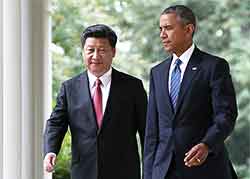When President Obama went to Beijing last November and met with Chinese President Xi Jinping, both leaders were aware of the litany of contentious issues that divided the United States and China. But a curious thing happened. Despite a host of intractable disagreements — maritime disputes in the South and East China Seas, cyber-hacking, human rights abuses, trade protectionism — the two countries found a new area of accord. They agreed to voluntarily set joint targets for carbon emissions reductions to peak by 2030.

Then, even as U.S.-China relations continued to unravel, the two leaders met again in Washington last month. Once again climate change was the issue that brought them together to “reaffirm their shared conviction that climate change is one of the greatest threats facing humanity and that their two countries have a critical role to play in addressing it.” Both leaders promised “to move ahead decisively to implement domestic climate policies, to strengthen bilateral coordination and cooperation, and to promote sustainable development and the transition to green, low-carbon, and climate-resilient economies.”
China agreed to match the U.S. by pledging $3.1 billion to help developing countries meet the climate change challenge and then went the U.S. one better: It promised to expand its seven experimental carbon markets into a nationwide cap-and-trade carbon emissions trading system.
As the two largest emitters of greenhouse gases, China and the U.S. are essential to any climate solution.
The U.S.-China relationship turned out to be an unexpected vessel into which despairing climate change activists could place their hopes. But climate change also proved to be an unexpected providence for the increasingly fraught U.S.-China relationship. Regularly touted as the most important bilateral relationship in the world today, Beijing’s relations with Washington had been unraveling under of a host of issues caused by China’s new assertiveness colliding with America’s “pivot to Asia” and Xi Jinping’s new assertiveness abroad and uncompromising authoritarianism at home. But now it suddenly seems to have some new lift under its wings. And heading into the international climate conference in Paris this December, people in other nations also feel encouraged by this new Sino-U.S. rapprochement.
Despite the fact that the U.S. is plagued by a Congress filled with climate deniers and that the Chinese Communist Party increasingly views the U.S. as out to covertly overthrow its one-party-system government, the two nations nonetheless managed to come together. And as world’s two largest emitters of greenhouse gases, China and the U.S. are the essential keystones of any global climate change solution arch, so their finally finding this common ground gives modest reason for optimism.
Unfortunately, like the proverbial elephant in the middle of the room, there still sits one extremely divisive problem that few want to recognize, because almost no one knows what to do about it, and it effects our bilateral ability not just to tackle climate change, but the myriad of other pressing problems — from pandemics and nuclear proliferation to terrorism and humanitarian crises — that afflict our world: The United States and the People’s Republic of China have fundamentally irreconcilable political systems and antagonistic value systems. We are a liberal democracy and they are a Leninist one-party state, and nobody quite knows how to factor an equation that includes democracy and autocracy. Yet, to collaborate, we are compelled to pretend this elephant isn’t in the room.
The fundamental contradictions between the U.S. and China make them unlikely collaborators.
The U.S. system of governance derives, of course, from a liberal democratic model stressing constitutionalism, multi-party electoral politics, rule of law, strong governmental checks and balances, and elaborate protections of the rights of the individual, a system purposefully adopted by our founding fathers as a bulwark against monarchical tyrannies. Our value system is drawn from the same wellspring of enlightenment ideals and stresses personal liberty, freedom, and the sanctity of the individual.
China’s one-party, Communist system, adopted from the Soviet Union during its darkest Stalinist period, is based on the Leninist principle of “democratic centralism” and the Marxist notion of the “dictatorship of the proletariat,” that prescribe a strong, hierarchal, uni-party political system organized around discipline, orthodoxy, and unity.
These fundamental contradictions make the U.S. and China unlikely partners for any kind of partnership, and yet here we are in a world that begs our collaboration for the sake of planetary survival.
The idea that two countries with such different political histories, values, and systems could ever cooperate grew out of two previous historic diplomatic breakthroughs. The first came in 1972 when Richard Nixon and Henry Kissinger visited Beijing to recast U.S.-China relations with Mao Zedong and Zhou Enlai as a hedge against the U.S.S.R., The second came in 1979 when Deng Xiaoping visited Washington to reestablish full diplomatic relations with President Jimmy Carter. Out of this rapprochement and Deng’s ambitious new program of “reform and opening up,” a presumption unfolded that China was, at last, beginning to join the West’s notion of history as heading ineluctably (a la Hegel) toward a more open and democratic horizon. Americans hoped that if we just helped it along with a little more free marketization and cultural exchange, slowly China’s political system would evolve and its values would change to become more like ours. It was a naive dream that we sometimes allowed ourselves to dream, if sometimes to doubt. It did, however, provide grounds for both countries to begin many kinds of constructive collaboration.
Unfortunately, this phase of collaboration ended in the bloodshed of 1989 when leaders in Beijing became alarmed at the way their dabbling in political reform almost landed the Chinese Communist Party on the ash heap of history. The result was an almost complete halt in further democratization.
One hopes that the sense of a common threat will change the whole global climate change equation.
Nonetheless, over the ensuing decades, through growing trade the two countries did manage to reknit the U.S.-China relationship back together well enough for both sides to begin imagining that, with more time, economic liberalization, educational exchange, civil society interaction, etc., China might yet evolve into a responsible “stakeholder,” as then-Deputy Secretary of State Robert Zoellick hopefully put it.
But since Xi Jinping’s investiture as Communist Party general secretary and president in 2013, he has made it abundantly clear that China is definitely not headed in any direction that is convergent with the West. President Bill Clinton once scolded his Chinese predecessor for being “on the wrong side of history.” Xi has made it emphatically clear that his China was on what he viewed as the “right side” of history, and one with distinctly “Chinese characteristics.” What is more, he seems to be suggesting that China had now also come up with its own viable model of development, one that might be described as “Leninist capitalism.” But if this model is China’s new historical endgame, the U.S.-China bilateral becomes deprived of any semblance of converging long-term political game plans. Instead of sharing the presumption of an even vaguely common political horizon, the two countries now find themselves traveling in diverging historical directions.
ALSO FROM YALE e360Will the Paris Climate Talks Be Too Little and Too Late?

But, mirabile dictum, climate change has come to the rescue! By reminding both sides that we exist in a common context and that there will be no solution to climate change — or many other global problems — without close collaboration between the U.S. and China, the two countries have been given an incipient new common purpose. Whether it will guide these two large, powerful, and often reckless nations into a new collective direction is now the question. Without such a compact, there is literally no hope of remedying climate change.
Although the two countries still disagree on many things, when President Obama welcomed Xi Jinping to the White House last month with a 21-gun salute on the South Lawn and a state dinner, the two not only took another important step toward such a remedy, but created new momentum that will help at international climate talks in Paris in December.
Such Sino-U.S. cooperation is a beguiling dream that is at last edging toward possibility. But, because of the static created by our very different political and values systems, it is still a somewhat naïve dream. Nonetheless, one can only hope that the new sense of a perceived common threat — one that is actually even more compelling than the menace of the Soviet Union back in the 1970s — will now be enough to change not only the U.S.-China relationship, but the whole global climate change equation.